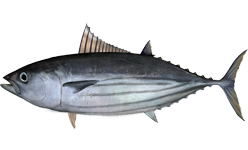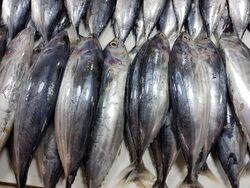Biology:Skipjack tuna
| Skipjack tuna | |
|---|---|

| |

| |
| Skipjack tuna in a Philippine fish market | |
| Scientific classification | |
| Domain: | Eukaryota |
| Kingdom: | Animalia |
| Phylum: | Chordata |
| Class: | Actinopterygii |
| Order: | Scombriformes |
| Family: | Scombridae |
| Subfamily: | Scombrinae |
| Tribe: | Thunnini |
| Genus: | Katsuwonus Kishinouye, 1915 |
| Species: | K. pelamis
|
| Binomial name | |
| Katsuwonus pelamis | |
| Synonyms | |
| |
The skipjack tuna (Katsuwonus pelamis) is a medium-sized perciform fish in the tuna family, Scombridae, and is the only member of the genus Katsuwonus. It is otherwise known as katsuo, arctic bonito, mushmouth, oceanic bonito, striped tuna or victor fish. It grows up to 1 m (3 ft) in length. It is a cosmopolitan pelagic fish found in tropical and warm-temperate waters. It is a very important species for fisheries.[2]
Common names
Skipjack tuna has a large number of common names.[3] In other languages, skipjack tuna is also known in Oceania as angarap (Northern Marianas); aku (Hawaii); atu (French Polynesia, Solomon Islands, Samoa, Tonga); yatu or i'a seu (Fiji); te ati or te atu (Kiribati); mwaali (New Caledonia); chilu (Marshall Islands); takua (Niue); and tjakalang (Papua New Guinea).[3]
In Southeast Asia, it is known as tulingan, budlisan, rayado, or bariles (the Philippines ); ame-ame, cakalang, tongkol kerai, or aya jepun (Indonesia, Malaysia); tongkol (Timor-Leste, Indonesia); and cá ngừ vằn (Vietnam).[3]
In South Asia, it is known as balaya (Sri Lanka); bugudi, gedar, or kuppa (India ); and godhaa (Maldives).[3]
In Africa, it is known as katunkel (South Africa ); kiri-kiri (Senegal); jodari (Kenya); sehewa (Tanzania, Kenya, Somalia); m'p'were (Comoros); m'bassi (Madagascar ); and listado (Mauritania).[3]
In Latin America, Spain , and Portugal, it is known as cachorreta, listado, rayada, bonito, barrilete, and gaiado.[3]
Description

It is a streamlined, fast-swimming pelagic fish, common in tropical waters throughout the world, where it inhabits surface waters in large shoals (up to 50,000 fish), feeding on fish, crustaceans, cephalopods, and mollusks. It is an important prey species for sharks and large pelagic fishes and is often used as live bait when fishing for marlin. It has no scales, except on the lateral line and the corselet (a band of large, thick scales forming a circle around the body behind the head). It commonly reaches fork lengths up to 80 cm (2 ft 7 in) and a mass of 8–10 kg (18–22 lb). Its maximum fork length is 108 cm (3 ft 7 in) and its maximum mass is 34.5 kg (76 lb). Determining the age of skipjack tuna is difficult, and the estimates of its potential lifespan range between 8 and 12 years.[2]
Skipjack tuna are batch spawners. Spawning occurs year-round in equatorial waters, but it gets more seasonal further away from the equator. Fork length at first spawning is about 45 cm (18 in). It is also known for its potent smell.[2]
Skipjack tuna has the highest percentage of skeletal muscle devoted to locomotion of all animals, at 68% of the animal's total body mass.[4][5]
Skipjack tuna are highly sensitive to environmental conditions and changes. Climate change effects are significant in marine ecosystems, and ecological factors may change fish distribution and catchability.[6]
Fisheries
It is an important commercial and game fish, usually caught using purse seine nets, and is sold fresh, frozen, canned, dried, salted, and smoked. In 2018, landings of 3.2 million tonnes were reported, the third highest of any marine capture fishery (after Peruvian anchoveta and Alaska pollock).[7] Countries recording large amounts of skipjack catches include the Maldives, France , Spain , Malaysia, Sri Lanka, and Indonesia.[8]
Skipjack is the most fecund of the main commercial tunas, and its population is considered sustainable against its current consumption.[9][10] Its fishing is still controversial due to the methodology, with rod and reel or fishery options being promoted as ecologically preferable.[11][12][13] Purse seine methods are considered unsustainable by some authorities due to excess bycatch, although bycatch is said to be much reduced if fish aggregation devices are not used.[14] These considerations have led to the availability of canned skipjack marked with the fishing method used to catch it.[15]
Skipjack is considered to have "moderate" mercury contamination. As a result, pregnant women are advised against eating large quantities.[16][17][18] In addition, skipjack's livers were tested globally for tributyltin (TBT) contamination. TBT is an organotin compound introduced into marine ecosystems through antifouling paint used on ship hulls and has been determined to be very toxic. About 90% of skipjack tested positive for contamination, especially in Southeast Asia, where regulations of TBT use are less rigorous than in Europe or the US.[19]
As food
Skipjack tuna is used extensively in Japanese cuisine, where it is known as katsuo (鰹/かつお). Besides being eaten seared (katsuo tataki (鰹のタタキ)) and raw in sushi and sashimi, it is also smoked and dried to make katsuobushi, the central ingredient in dashi (a common Japanese fish stock).[20] It is also a key ingredient in shuto.
In Indonesian cuisine, skipjack tuna is known as cakalang. The most popular Indonesian dish made from skipjack tuna is cakalang fufu from Minahasa. It is a cured and smoked skipjack tuna dish, made by cooking the fish after clipping it to a bamboo frame.[21] Skipjack known as kalhubilamas in Maldives is integral to Maldivian cuisine.[22]
Skipjack tuna is an important fish in the native cuisine of Hawaii (where it is known as aku) and throughout the Pacific islands. Hawaiians prefer to eat aku either raw as a sashimi or poke or seared in Japanese tataki style.[23]
The trade in pickled skipjack tuna is a driving force behind the commercial fishery of this species in Spain.[24]
References
- ↑ Collette, B.; Acero, A.; Amorim, A.F. et al. (2011). "Katsuwonus pelamis". The IUCN Red List of Threatened Species 2011: e.T170310A6739812. doi:10.2305/IUCN.UK.2011-2.RLTS.T170310A6739812.en.
- ↑ 2.0 2.1 2.2 Collette, Bruce B.; Cornelia E. Nauen (1983). FAO species catalogue. Vol. 2. Scombrids of the world. An annotated and illustrated catalogue of tunas, mackerels, bonitos and other related species known to date. FAO Fisheries Synopsis. Rome: Food and Agriculture Organization of the United Nations. p. 137. ftp://ftp.fao.org/docrep/fao/009/ac478e/ac478e00.pdf.
- ↑ 3.0 3.1 3.2 3.3 3.4 3.5 "Common names of Katsuwonus pelamis". https://fishbase.mnhn.fr/ComNames/CommonNamesList.php?ID=107&GenusName=Katsuwonus&SpeciesName=pelamis&StockCode=121.
- ↑ Calder, William A. (1996) (in en). Size, Function, and Life History. Courier Corporation. pp. 19. ISBN 978-0-486-69191-6. https://books.google.com/books?id=-iBS6-2OO3wC&pg=PA19.
- ↑ Bone, Q. (1978) (in en). Locomotor muscle. Fish physiology: Academic Press. pp. 362. ISBN 978-0-08-058527-7. https://books.google.com/books?id=wnjnyAafAzUC&dq=bone%201978%20locomotor%20muscle&pg=PA362.
- ↑ Yen, Kuo-Wei; Su, Nan-Jay; Teemari, Tooreka; Lee, Min-An; Lu, Hsueh-Jung (2016-12-01). "PREDICTING THE CATCH POTENTIAL OF SKIPJACK TUNA IN THE WESTERN AND CENTRAL PACIFIC OCEAN UNDER DIFFERENT CLIMATE CHANGE SCENARIOS". Journal of Marine Science and Technology 24 (6). doi:10.6119/JMST-016-0713-1. ISSN 1023-2796. https://www.airitilibrary.com/Publication/alDetailedMesh?DocID=10232796-201612-201612270055-201612270055-1053-1062.
- ↑ The State of World Fisheries and Aquaculture 2020. Food and Agriculture Organization. 2022. doi:10.4060/cc0461en. ISBN 978-92-5-136364-5. https://www.fao.org/state-of-fisheries-aquaculture. Retrieved 2022-03-08.
- ↑ Makoto Miyake; Naozumi Miyabe; Hideki Nakano (2004). Historical trends of tuna catches in the world. FAO Fisheries Technical Paper No. 467. Rome: Food and Agriculture Organization of the United Nations. http://www.fao.org/docrep/007/y5428e/y5428e00.htm.
- ↑ "FishWatch: Atlantic Skipjack Tuna (Katsuwonus pelamis)". National Oceanic and Atmospheric Administration. November 3, 2009. http://www.nmfs.noaa.gov/fishwatch/species/atl_skipjack.htm.
- ↑ "Skipjack tuna, purse seine caught". Blue Ocean Institute. November 11, 2009. http://www.blueocean.org/programs/seafood-view?spc_id=54.
- ↑ "BUSINESS: PACIFIC TOLD TO TAKE THE LEAD If region wants to conserve critical resource". Islands Business International. November 2009. http://www.islandsbusiness.com/islands_business/index_dynamic/containerNameToReplace=MiddleMiddle/focusModuleID=18926/overideSkinName=issueArticle-full.tpl.
- ↑ "Pacific tries to show way in sustainable tuna fishing". ABC International - Radio Australia. October 23, 2009. http://www.radioaustralia.net.au/pacbeat/stories/200910/s2722094.htm.
- ↑ "Retailers' Guide to Sustainable and Equitable Pole and Line Skipjack". Greenpeace International. 27 April 2009. http://www.greenpeace.org/international/press/reports/retailers-guide-skipjack.
- ↑ "Tuna, Skipjack". Monterey Bay Aquarium. http://www.seafoodwatch.org/cr/seafoodwatch/web/sfw_factsheet.aspx?gid=78.
- ↑ Schwartz, Ariel (2012-09-30). "How Safeway Ended Up Selling Cheap, Responsibly-Caught Store Brand Tuna". Fast Company. http://www.fastcoexist.com/1680610/how-safeway-ended-up-selling-cheap-responsibly-caught-store-brand-tuna.
- ↑ "Mercury Levels in Sushi". http://www.americanpregnancy.org/pregnancyhealth/sushimercury.htm. Retrieved 2013-08-22.
- ↑ "Mercury Levels in Fish". http://www.nrdc.org/health/effects/mercury/guide.asp. Retrieved 2013-08-22.
- ↑ "Advice for Pregnant Women on Fish Consumption concerning Mercury Contamination". 2003-06-03. http://www.mhlw.go.jp/english/wp/other/councils/mercury/index.html. Retrieved 2013-08-22.
- ↑ Down, Steve. "Tuna is attuned to tin". separationsnow.com. http://www.separationsnow.com/details/ezine/sepspec503ezine/Tuna-is-attuned-to-tin.html?tzcheck=1.
- ↑ Sperss, Phil. "How to prepare skipjack tuna for nigiri sushi". https://lapetitnoisette.com/2019/08/22/how-to-prepare-skipjack-tuna-katsuo-%e9%b0%b9-%e3%82%ab%e3%83%84%e3%82%aa-for-nigiri-sushi/.
- ↑ "Cakalang Fufu Jadi Pilihan di Sulut" (in id). MediaIndonesia.com. 15 July 2011. http://www.mediaindonesia.com/read/2011/07/07/242079/290/101/Cakalang-Fufu-Jadi-Pilihan-di-Sulut.
- ↑ Prince, Rose (11 March 2010). "Tuna fishing in the Maldives: the fairest catch". The Telegraph. https://www.telegraph.co.uk/foodanddrink/7413598/Tuna-fishing-in-the-Maldives-the-fairest-catch.html.
- ↑ "Skipjack Tuna (Aku)". https://www.hawaii-seafood.org/wild-hawaii-fish/skipback-tuna-aku/.
- ↑ Pesca y Acuicultura
Sources
- Pacific skipjack tuna NOAA FishWatch. Retrieved 5 November 2012.
- Western Atlantic skipjack tuna NOAA FishWatch. Retrieved 5 November 2012.
External links
- Photos of Skipjack tuna on Sealife Collection
Wikidata ☰ Q633957 entry
 |








